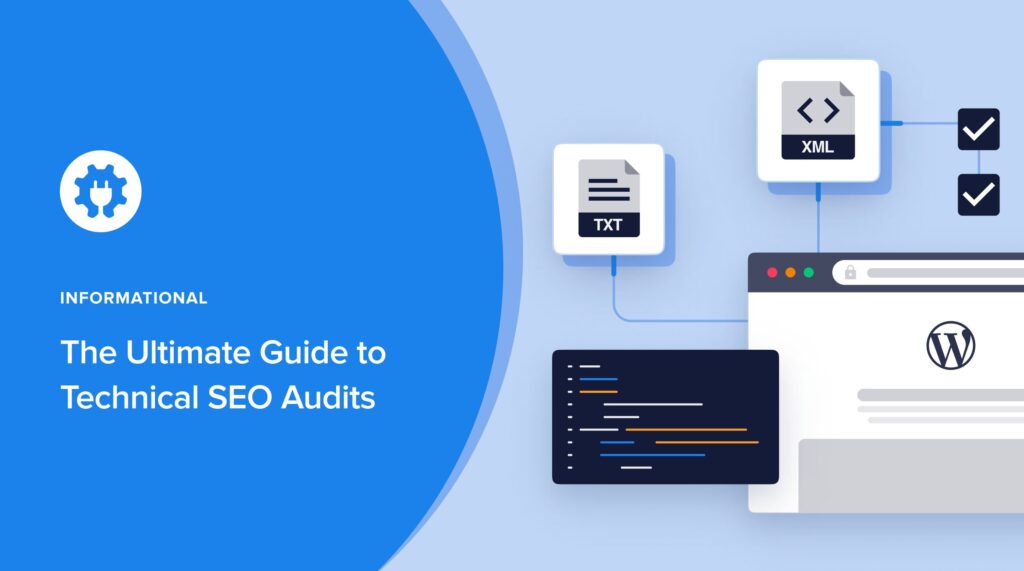If you're a WordPress user looking to improve your website's search engine rankings, conducting a technical SEO audit is a crucial step.
Technical SEO focuses on optimizing the behind-the-scenes elements of your site to ensure search engines can easily crawl, index, and rank your content.
While the process may seem daunting, especially for beginners and intermediate users, the good news is that you can use an SEO plugin to simplify the audit process.
In this article, we'll guide you through the essential steps of a basic technical SEO audit.
You'll gain a solid understanding of how to identify and resolve technical issues hindering your site's performance, ultimately helping you achieve better search engine visibility and drive more organic traffic to your WordPress site.
In This Article
What is Technical SEO?
Technical SEO focuses on ensuring that search engines can easily crawl, index, and understand the content on a website.
The definition is subjective and usually includes factors that some think require SEO professionals.
We’ll define technical SEO as optimizing elements such as site structure, navigation, page speed, mobile-friendliness, structured data, and XML sitemaps.
By addressing these technical factors, website owners can enhance their site's search engine performance and provide a better user experience for their visitors.
What’s a Technical SEO Audit?
A technical SEO audit is a systematic check of a website's technical elements and infrastructure to identify issues that may hinder its search engine performance.
This type of audit may assess factors such as site speed, mobile-friendliness, indexation, crawlability, structured data, JavaScript, and site architecture.
Why Perform a Technical SEO Audit?
The goal of a technical SEO audit is to uncover and resolve any technical barriers preventing search engines from effectively crawling, indexing, and ranking the website's content.
By conducting a thorough audit and implementing the necessary optimizations, website owners can improve their site's visibility, user experience, and overall search engine rankings.
About Our Approach
This article is geared toward the adventurous beginner who already knows how to use an SEO plugin to optimize on-page content. Those moving on to intermediate knowledge of SEO will also benefit from this article.
We’ll use 3 beginner-friendly tools to conduct our technical SEO audit.
Technical SEO Audit Tools
Those tools are:
- AIOSEO Analyzer: This free Chrome extension provides fast checks of a website, and there’s no need to login.
- All in One SEO (AIOSEO): This SEO plugin will enable us to correct technical errors in simple ways.
- Google Search Console: This is a free tool that’s helpful for debugging website issues related to search results.
After you install the first 2 tools and sign up for Google Search Console you’re ready to move on.
Technical Audit SEO Checklist
There’s no specific order that you need to do these steps in. We’ve placed simple checks at the beginning. But feel free to re-order the technical SEO audit steps to suit your preferences.
We’ll start by checking to see if a site has both an XML sitemap and an RSS/Atom sitemap.
And we’ll check to see if there are any issues with these sitemaps.
Check Sitemaps
Background: Your first technical SEO audit check will be to verify that the site has both an XML and an RSS/Atom sitemap.
Here’s the difference between them:
- An XML sitemap contains all URLs on a website.
- An RSS/Atom sitemap contains only recently modified or published pages.
Google recommends having both types of sitemaps.
As you might guess, Google’s crawlers will visit the RSS/Atom sitemap more frequently than the XML sitemap.
How do WordPress Users Get Sitemaps? WordPress automatically generates an XML sitemap for all WordPress users.
When you install the AIOSEO plugin it will automatically generate both an XML sitemap (that’s styled, and easy to read) and an RSS sitemap. These sitemaps are 100% maintenance-free.
Sitemap Audit
Verify presence:
- You can find the XML sitemap at yourdomain.com/sitemap.xml
- You can find the RSS sitemap at yourdomain.com/sitemap.rss
Some websites, like CNN.com, place their sitemap at a different URL than sitemap.xml. However, the majority of all WordPress websites use the URLs defined above.
You can also verify the presence of an XML sitemap by navigating to the site being tested, and clicking on the AIOSEO Analyzer icon. (This icon will appear on your Chrome browser after you install the Analyzer.)
Scroll down the extension overlap and you’ll see a URL: sitemap.xml.
Click on it to verify presence of an XML sitemap.
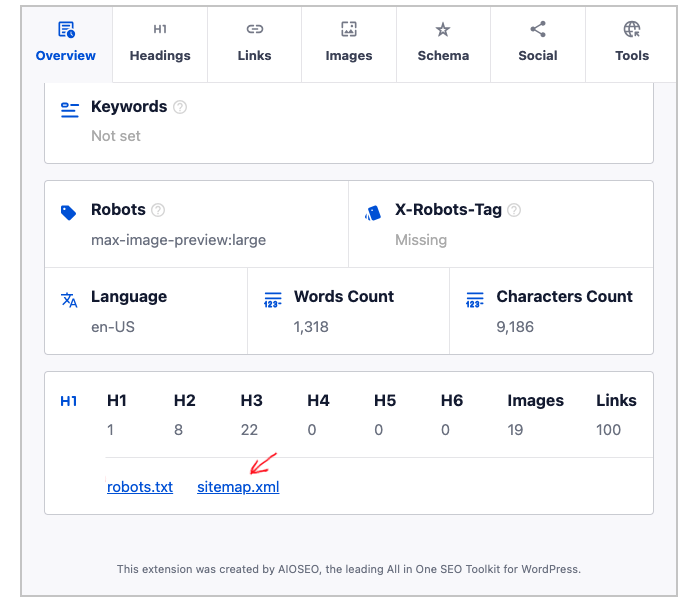
No RSS sitemap? If there’s no RSS/Atom sitemap, then install AIOSEO on the site so the RSS sitemap is automatically generated.
Check for problems: If you’re using All in One SEO, there won’t be problems with your sitemaps. But if you aren’t using it, log into Google Search Console and look for any error messages that cite sitemaps.
The only time I’ve run into sitemap issues, is when I was checking a non-WordPress website. Specifically this was a site built with Hugo, a static site generator.
The website’s theme came bundled with a sitemap that omitted the blog’s landing page. In addition, the blog landing page had a “noindex” tag added. So that landing page wasn’t showing up in search results.
Thankfully this was easy to fix because Google Search Console specified the exact problems.
Learn more about AIOSEO sitemaps in 5 Sitemap Best Practices.
Internal Linking
Next, you’ll check internal linking. Here, All in One SEO’s Link Assistant will be helpful.
Background: Internal linking helps Google’s crawlers find your content. In addition, this linking should express a hierarchy: the most important pages of a site should have more internal links pointing to them.
These important pages may be:
- A top product or service
- The pillar page for a topic cluster.
Using Link Assistant
For this audit, you’ll log into the WordPress website.
In the admin bar, under AIOSEO, click on Link Assistant.

Check for orphan pages: In Link Assistant, click on the tab for orphan pages.
Orphans are pages that have no internal links to them. It’s common for newly published content to be ‘orphaned.’ But it’s also easy to forget about those pages, so the site being audited may have hundreds of orphan pages.
For the audit, you won’t add the links, you’ll just make a note of the number of pages that are orphaned and that this task needs to be done.
If there are hundreds of such pages, it will take a while for the site owner or client to work through this.
They can use Link Assistant to get recommendations of internal links to their orphan pages. And they can do all that in one window, without navigating to each page.
Learn more in Find and Fix Orphan Pages.
Mark Pillar Pages as Cornerstones
Identify pillar pages: If the site owner is using topic clusters, ask them for a list of the related pillar pages.
Once these are identified, they should be marked individually as “Cornerstone Content” in the AIOSEO sidebar.
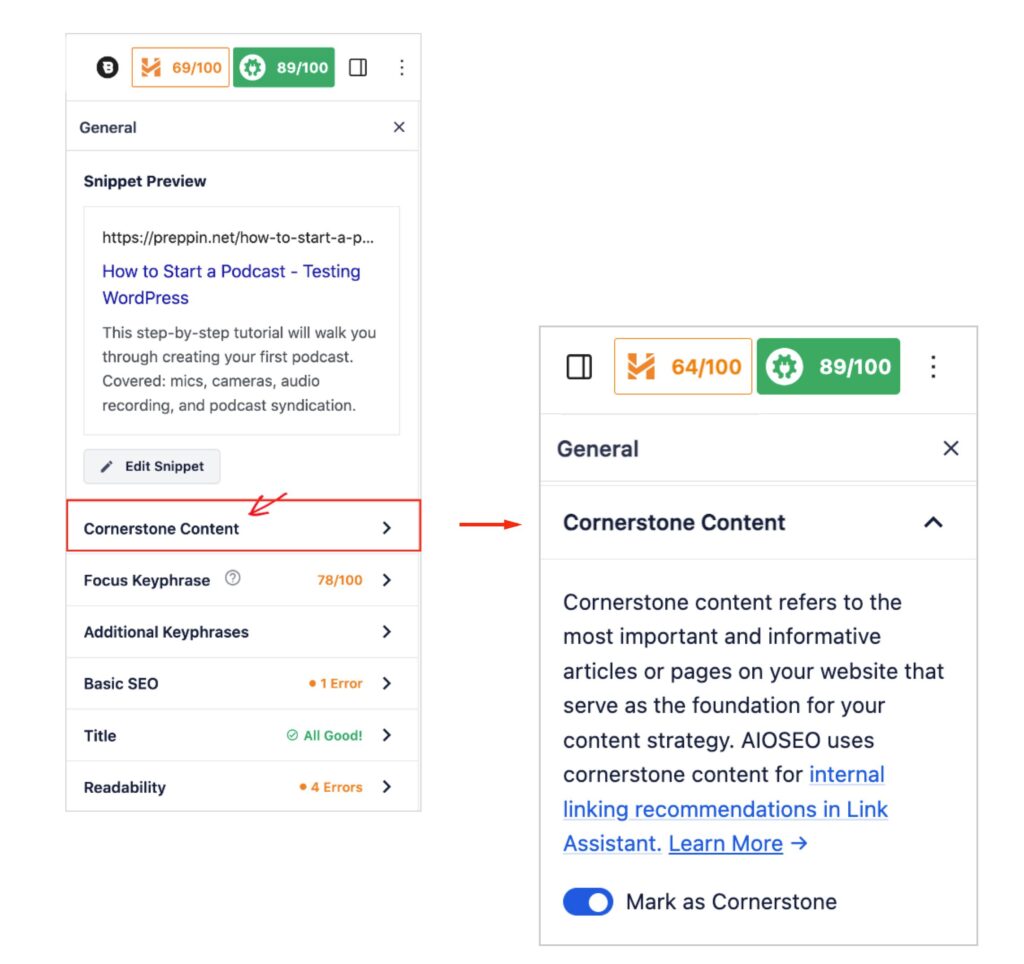
Doing this will cause Link Assistant to prioritize link recommendations to those pages.
Breadcrumb Navigation
Consider recommending breadcrumbs: Breadcrumb navigation can help with internal linking, particularly if schema markup is added.
Site owners can use AIOSEO to generate breadcrumbs, and the plugin will automatically add the related schema markup code. That code helps Google understand the content of those links.
Fix Broken Links
Find and Fix Broken Links: Internal links that are broken can cause loss of conversions and visitor dissatisfaction.
That said, 404s (broken links) aren’t bad per se. When 404s become an SEO problem is when there are lots of them on a site.
Case in point: I was asked to help a client resolve an issue with a website vendor. The vendor had created a website redesign. In the process most of the website URLs were changed, but no 301 redirects were set up.
As a result, when the site re-launched, it had an organic search decline of 48%.
When you’re auditing a site, it probably won’t be right after a redesign. That makes your job easier.
To find broken links on a WordPress site you can use a plugin like Broken Link Checker. What I like about this plugin is it uses AIOSEO’s servers, not yours! That’s important for security and cost.
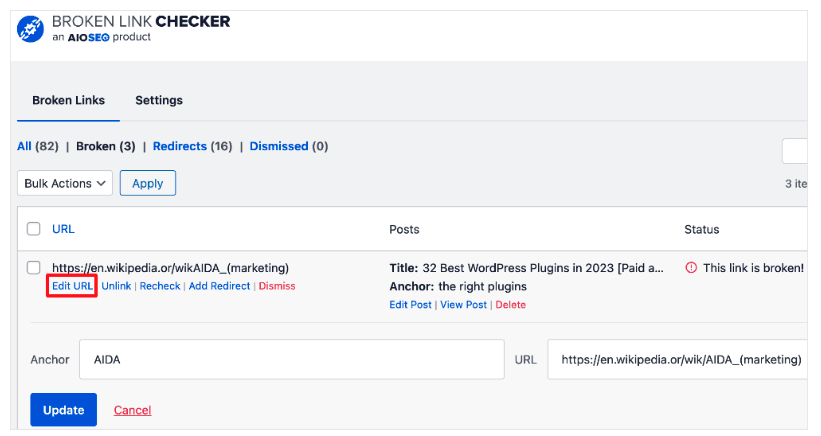
The plugin starts at $4.99/month. It will create a list of all broken URLs. In the plugin interface, you can either redirect those broken links or replace or remove them.
Learn more in How to Find and Fix Broken Links in WordPress.
Online Store Considerations
Online stores with many products (and product attributes) may have complex audit needs.
These may relate to URL structure and product variant pages that use query arguments (“query args” for short.)
Learn more about the unique technical aspects of online stores in this Semrush course.
And learn how to manage query args in WordPress.
Crawling and Indexing
Now let’s move on to crawling and indexing issues.
Robots.txt file and Robots Exclusion Protocol
Background: The robots.txt file is located in the root directory of a website and can be located at domainname.com/robots.txt.
This file allows directives to be added which ask specific web crawlers (such as those for Google Search or Bing) to avoid crawling the page.
However, there’s no guarantee that the directives will be followed by all crawlers. For instance, Chrome extensions that serve to scan a page for email contacts might not follow the robots.txt directives.
In addition, different crawlers vary in their ability to handle wildcards, which Googlebot can read.
Also: excluding URLs using the robots exclusion protocol doesn’t guarantee confidentiality. To keep a web page secret or inaccessible to the public, other methods such as HTTP authentication should be used.
Audit the Robots.txt File:
- Verify there’s a robots.txt file for the site. You can do this by navigating to domainname.com/robots.txt or click on the AIOSEO Analyzer and scroll down the window overlay. Click on the robots.txt hyperlink.

- Check for blocked resources: Simply viewing the robots.txt file should show you if any pages were accidentally blocked by someone who edited the robots.txt file.
- Unblock pages: If pages have been accidentally blocked from search results by the robots.txt file, you can edit the robots.txt file and remove the directive in question. AIOSEO provides a simple user interface for doing this. No coding is required.
Learn more in our robots.txt guide.
Crawl Budget Optimization
Lots of SEO articles advise optimizing your crawl budget.
But crawl budget optimization is something most site owners will never need to deal with.
Why? As I explained in Sitemap Best Practices: “Crawl budget is a somewhat opaque subject that generates speculation. Google’s John Mueller has said that even with 100k URLs a site would not need to be concerned about crawl budget.”
What if your site is very large?
- Then read Google analyst Greg Illyes’s article What Crawl Budget Means for Googlebot.
- And check out Google’s advanced guide on Managing Crawl Budget.
The latter guide is for:
- Sites with 1 million+ pages
- Medium or larger sites (10,000+ pages) with daily content changes.
Canonical Tags
Background: Canonical tags are HTML elements, placed in the <head> section of a web page, and used to specify the preferred version of that page for search engines to index and rank.
Between 2 duplicate pages, or pages that are nearly identical, the site manager would choose 1 to be indexed. The duplicate page(s) then would receive a canonical tag, pointing to the preferred page.
The preferred page is referred to as the canonical URL.
The syntax for canonical tags is highlighted below:
<head>
<title>Get Your Angry Birds T-Shirt!</title>
<link rel="canonical" href="https://yourdomain.com/tshirts/angry-birds" />
<!-- other elements -->
</head>Using canonical tags avoids dilution of search engine ranking signals and the potential for the preferred page to rank unnecessarily low.
Adding Canonical Tags in AIOSEO
The All in One SEO sidebar, visible in your WordPress editor, offers an easy way to add a canonical tag.
Navigate to a duplicate page.
Then, in the AIOSEO sidebar, click Advanced and then add the canonical URL to the page.

Before we discuss canonical tags in more detail, it’s worth noting that Google says: “[Y]our site will likely do just fine without specifying a canonical preference. That's because if you don't specify a canonical URL, Google will identify which version of the URL is objectively the best version to show to users in Search.”
That said, let’s explain more about canonicals.
International SEO Uses
Canonicals can also be useful for region-specific pages. For instance, a French website may have a product page targeting people who live in Europe and near-duplicates for those living in Cote d’Ivoire, La Réunion, and Canada. Using canonicalization can prevent country-based search results from being cluttered with confusing variants.
Learn more from Google’s guidance on international page variants.
Limitations: Google views your canonical tags as a suggestion: “We’ll take your preference into account, in conjunction with other signals, when calculating the most relevant page.”
Other signals Google may consider could be quality and number of backlinks to the page and whether the preferred page is included in your sitemap.
Canonical URL Audit
Canonical URL Audit: The 1st goal is to identify all canonical URLs on your site. Then, you’ll check in Google Search Console to see if the preferred URL is indexed.
To identify all canonical URLs on your site, use the free Screaming Frog SEO Spider. Make sure “Canonicals” is checked in the dropdown.
- Then enter your domain and click the green Start button.
- Underneath the Screaming Frog logo, click the Canonicals tab.
There you’ll see the complete list of URLs that are preferred pages that duplicate pages point to.
Next, log into Google Search Console.
- Click URL Inspection in the left-hand column.
- Then in the field at top, enter, one-by-one, your preferred URLs. If Google has indexed your preferred URL you’ll see a message like this.
Google’s guidelines provide troubleshooting tips. Among those listed are:
- Copying content: A website steals your page content and publishes it on their site. Their version ranks higher than yours. This one is rare but easy to fix. You’ll file a DMCA notice with Google so they’ll take down the imposter page.
- Hacking: A hacker breaches your website and inserts a canonical tag pointing to one of their pages. Here, you’d report the issue via Google Search Console.
Page Speed
Background: Page speed refers to objective loading data and subjective perceptions by users.
Page loading speed can be a ranking factor, but Google weighs content quality above speed. And there’s a relative aspect to this.
If your page is ranking #3 for its keyword and there are no large speed discrepancies between the other pages ranking high, improving your speed might not be a priority for you.
Statistics on Page Loading Speed
That said, research has repeatedly shown that even tiny improvements in page loading speeds can have dramatic impact on conversion rates.
For instance,
- A 1-second delay in page load time can lead to a 7% reduction in conversions. (Source: Akamai, 2017)
- A 0.1s change in site speed can influence every step of the user journey, including bounce rates, page views, and conversions. (Source: Deloitte, 2019)
- 70% of consumers admit that page speed impacts their willingness to buy from an online retailer. (Source: Unbounce, 2019)
- For every additional second of load time, conversions can fall by up to 20%. (Source: Hubspot, 2021)
Audit Site Loading Speed
To audit your loading speed, start with your homepage, then move on to important product or service pages.
Go to Google’s PageSpeed Insights and enter a URL into the blank field.
The circular Performance and Best Practices scores relate to speed.

Scroll down and you’ll find detailed analyses with links to documentation.
Realize that PageSpeed Insights is designed for web professionals so most of the metrics and recommendations will seem obscure to lay people.
Nevertheless, if you’re conducting an audit for a client you can use the results to make recommendations. The client will then need to hire a web developer to implement those recommendations.
If you have an intermediate knowledge of HTML, CSS, and JavaScript, you will likely be able to make some basic improvements on your own. These may include;:
- Bundling CSS and JavaScript files together
- Minifying those files
- Hosting fonts locally
- Improving image load speeds
Pro tip: Some web hosts, like Netify Edge, allow you to bundle CSS and JavaScript files, respectively, into 1 single file, by ticking a checkbox.
Ask your web host if this service is available to you.

Backlinks
Backlinks from trustworthy websites can boost your rankings.
Not all technical SEO audits will deal with backlinks. Remember, all SEO audits are customized to the client’s needs.
Let’s take a quick look at backlink audit tools as well as problem backlinks.
Backlink Audit Tools
There are a range of backlink audit tools. Some of the best are bundled with keyword research tools like Ahrefs and Semrush.
Then there’s Austria-based Link Research Tools, a unique software platform dedicated to backlinks and used by professionals.
Paid Links, Manual Penalties, and Disavowals
If you pay for backlinks, in the hopes that will be a shortcut for improved rankings, you can run afoul of Google and incur “manual penalties.”
Paying for links to gain rankings is against Google’s policies.
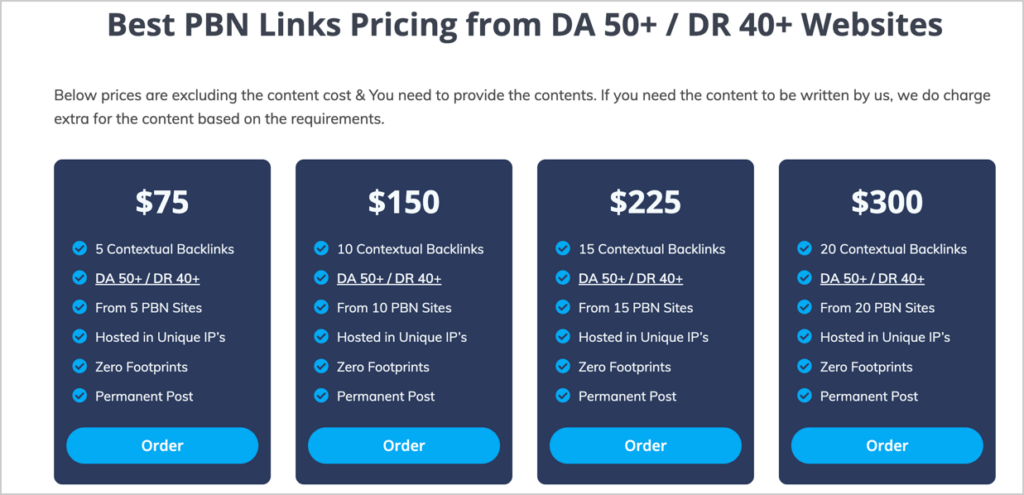
There are SEO professionals dedicated to trying to recover websites after manual penalties. This sometimes includes link disavowals.
Recovery isn’t always possible. Every SEO pro has a story about a website, which a year after the penalty, is still excluded from Google Search.
Learn more in our guidance on paid links.
Paying for advertorial-style links is fine as long as a nofollow or sponsored tag is added to the backlink to your website.
Site Security
Site security is a must and absence of basic measures may impact your rankings or traffic.
HTTPS and SSL
Every site should be using HTTPS. This is a protocol that ensures when people fill out forms on your site, their information is secure.
How do you know if a site is using HTTPS?
Look for the lock icon in your web browser.

How do you get HTTPS? Get a SSL certificate. These are typically available from your web host.
Be aware that many sites offer free SSL certificates from the Let’s Encrypt organization.
Checkout Security
Be sure to use secure checkout systems like industry-leader Stripe.
You can add Stripe to your WordPress website with the WP Simple Pay plugin.
Structured Data
Some technical audits may check for structured data. Think of structured data as tags that only Google sees.
These tags help search engines understand the content of a page and rank it for relevant keywords.
So how do these tags get added to pages? Through a code called schema markup.
Schema Markup
With All in One SEO you can easily add schema markup to pages by clicking some buttons and filling out some form fields.
There’s no need to deal with code. Once you choose the schema type, AIOSEO will automatically add the required schema markup.
AIOSEO offers 18 types of schema markup, including:
- Recipe schema
- Video schema
- Product schema
- Product review schema
- And more.
Rich Snippets
In addition to helping Google rank your pages, some types of schema markup make your page eligible to be displayed as a “rich snippet.”
You can think of rich snippets as super-deluxe search displays.
For example, these results are rich snippets.

And so is this.

Notice that rich snippets include special information like multiple images, prices, delivery and return information, and product ratings.
On-Page SEO
Technical SEO audits will likely not delve into basic on-page SEO.
You can easily check on-page factors by using All in One SEO. The plugin will automatically analyze all of a site’s pages.
Then it makes recommendations for improvement.
Some page aspects that AIOSEO analyzes include:
- Titles and meta descriptions
- Use of a focus keyword (also called a focus keyphrase)
- Readability including use of short sentences
- Formatting to make your page scannable
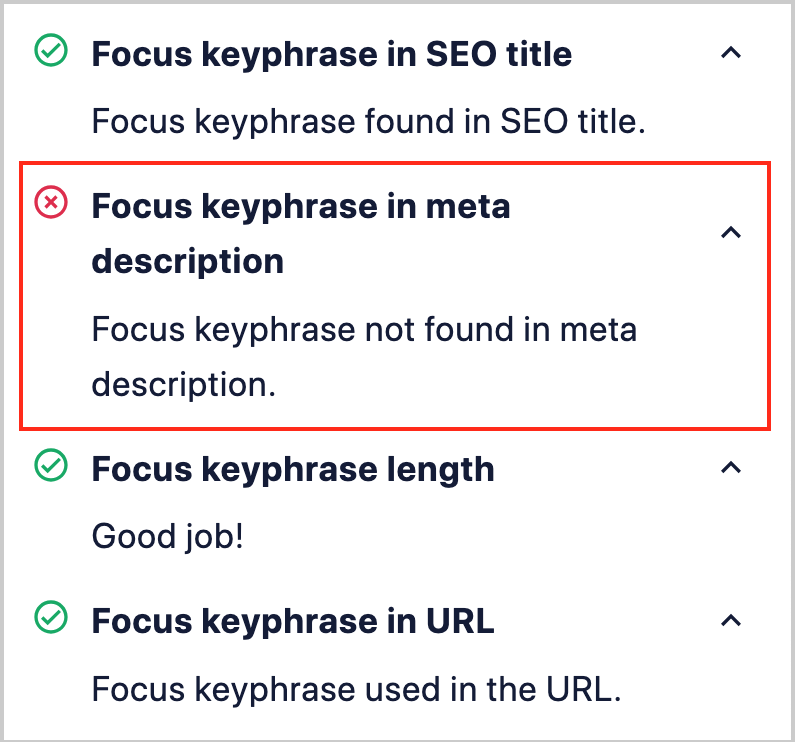
Above: Examples of AIOSEO’s analysis.
Analysis of on-page factors may include:
- Placement and use of calls-to-action (CTAs)
- Use of the inverted pyramid
- Quality and EEAT.
Now, let’s move on to some Q&As.
Q&A on Technical SEO Audits
How long does a technical SEO audit take?
How long a technical SEO audit takes depends on several factors, including the size and complexity of the website, the scope of the audit, and the experience level of the person or team conducting the audit.
However, we can provide a general estimate based on common scenarios:
Small websites (less than 1,000 pages):
Basic audit: 1-2 days
Comprehensive audit: 3-5 days
Medium-sized websites (1,000 to 10,000 pages):
Basic audit: 3-5 days
Comprehensive audit: 1-2 weeks
Large websites (Hundreds of thousands of pages or 1 million+ unique pages)_
Basic audit: 1-2 weeks
Comprehensive audit: 2-4 weeks or more
A basic audit typically covers essential technical SEO factors such as crawlability, indexation, site structure, page speed, mobile-friendliness, and (perhaps) basic on-page elements.
A comprehensive audit delves deeper into technical aspects and may include JavaScript rendering, international SEO, log file analysis, and more.
It's important to note that these are rough estimates. The actual time required for an audit can vary significantly based on the website's specific characteristics, problems the website may have, and the auditor's approach.
Additionally, the time mentioned above is for conducting the audit itself and doesn’t include the time needed to implement the recommended optimizations, which can vary depending on the complexity of the issues identified and the resources available.
How do I prepare for a technical SEO audit?
Preparing for a technical SEO audit involves gathering essential information and resources to ensure a smooth and effective auditing process. Here are some key steps to help you prepare:
- Define your goals: Clearly outline what you want to achieve from the audit, such as improving organic traffic, fixing specific issues, or identifying growth opportunities.
- Gather website documentation: Collect all relevant information about your website, including its structure, content management system (CMS), hosting setup, and any previous SEO efforts or audits.
- Provide access: Ensure that the person or team conducting the audit has access to your accounts, such as your domain registrar, Google Analytics, Google Search Console, and your website's backend (e.g., WordPress admin panel).
- Prepare a list of known issues: If you're aware of any existing technical SEO issues or concerns, make a list to help guide the auditor's focus.
- Identify your target audience and competitors: Provide information about your target audience and main competitors to help the auditor understand your market and benchmark your website's performance.
- Communicate with stakeholders: Inform all relevant stakeholders, such as developers, content creators, and management, about the upcoming audit.
- Allocate resources: Ensure that you have the necessary resources, such as time, budget, and personnel, to implement the recommendations from the audit.
- Set up a staging environment (optional): If possible, set up a staging or development environment where changes can be tested before being implemented on the live site to minimize potential disruptions.
By following these preparatory steps, you'll be well-equipped to facilitate a comprehensive and efficient technical SEO audit that can drive meaningful improvements to your website's search engine performance.
Can a beginner conduct some aspects of a technical SEO audit?
Yes, a beginner can conduct certain aspects of a technical SEO audit, especially with the help of software tools.
While a comprehensive audit may require more advanced knowledge and experience, beginners can start by focusing on the following areas mentioned in this article:
- Crawlability
- Indexation
- Site structure and navigation
- Page speed
- Mobile-friendliness
- On-page elements
- Sitemaps
For beginners using WordPress, All in One SEO can help simplify the process by providing guidance, recommendations, and automated checks for various technical SEO aspects.
As you gain more experience and knowledge, you can progressively dive deeper into more advanced technical SEO concepts and tools to conduct comprehensive.
For beginners using WordPress, All in One SEO can help simplify the process by providing guidance, recommendations, and automated checks for various technical SEO aspects.
As you gain more experience and knowledge, you can progressively dive deeper into more advanced technical SEO concepts and tools to conduct comprehensive.
How do I know whether I need a technical SEO audit?
A technical SEO audit can be beneficial for sites that are experiencing unresolved issues with search engine rankings or website performance.
Here are some signs that indicate you may need a technical SEO audit:
- Poor search engine rankings: If your website is not ranking well for relevant keywords despite having quality content, it may be due to technical SEO issues.
- High bounce rates: If visitors are leaving your website quickly, it could be a sign of technical issues like slow loading times, poor navigation, or broken links. This issue is related to maximizing your benefit from SEO.
- Indexing problems: If some of your pages aren’t appearing in search results, then you may have an indexing problem. This can be caused by issues with your robots.txt file, noindex tags, sitemap, or URL structure.
- Mobile responsiveness: With the majority of web searches occurring on mobile devices, having a mobile-friendly website is crucial. If your site, popups and web forms are not mobile-responsive, it can impact your search rankings and user experience.
- Website redesign or migration: If you've recently redesigned your website or migrated to a new domain, it's essential to conduct a technical SEO audit to ensure there won’t be issues with redirects, broken links, and lost search engine rankings.
- Slow website speed: Search engines may prioritize fast-loading websites. If your site is slow, it can negatively impact your rankings and user experience.
Regarding that last point, Google emphasizes quality content above speed. So there’s a relative aspect to this.
- If the sites ranking near you all roughly load at the same speed, then boosting your speed may not impact rankings. That said, a faster site may boost conversions, especially from smartphone users.
- Also: if your page loading speeds are significantly slower than your competitors, you should fix this issue.
After Doing a Technical SEO Audit
Now that you understand technical SEO audits, what’s next?
Find out how to speed up your WordPress website, without hiring a pro. And learn how to avoid SEO scams, which target small businesses.Don’t forget to plan for conversions and set up mobile-friendly web forms to capture contact information.
Join us on our YouTube Channel for short WordPress SEO tutorials. And follow us on X (Twitter), LinkedIn, or Facebook to stay in the loop.
Disclosure: Our content is reader-supported. This means if you click on some of our links, then we may earn a commission. We only recommend products that we believe will add value to our readers.
